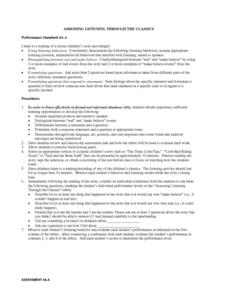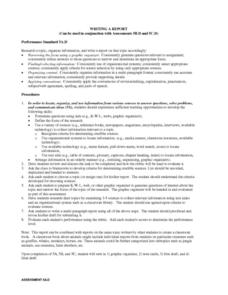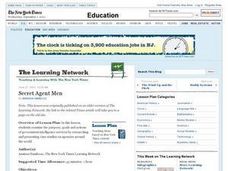Curated OER
Family Names
Young scholars draw a family tree. They label familiar items (e.g., family members, classroom objects, and pets). Pupils are given a copy of the worksheet "Family Name," they draw a family tree, label themselves and at least 10...
Curated OER
If I Could Have Lived in Another Time or Culture
Third graders develop multi-paragraph compositions. They include an introduction, first and second level support, and a conclusion. They use a variety of sentence structures (e.g., simple, compound/complex) and sentence types (i.e.,...
Curated OER
User Friendly
Learners explore how consumers have become as proficient in computer technology as specialists were a decade ago. They create and conduct a test to determine the proficiencies of people in their school community.
Curated OER
EXPRESSING AN IDEA
Students explain how elements (body, space, time, and force) can be contrasted to express anger and happiness in movement. They give examples for each of the elements: body actions, speed and force of movement. They display their...
Curated OER
WRITE A STORY
Third graders compose two or more simple sentences in response to a picture. They construct sentences and produce captions with 3 or more sentences that extend the subject/verb pattern. They demonstrate age appropriate correct use of...
Curated OER
CREATE A NEW RHYME
Third graders develop basic narratives. They retell a focused story and create a basic publication using available resources (e.g., pictures, colors, computer, copier). They experiment with different forms of creative writing (e.g.,...
Curated OER
TELL THE SEQUENCE IN AN ORAL REPORT
Second graders survey a favorite story he/she has read or heard read aloud. They use the graphic organizer to draw illustrations that show the beginning, middle and end of the story. They tell the title of the story, whether it is...
Curated OER
Chords and Triads
In this music worksheet, students answer 15 questions related to chords and triads. For example, "A triad is a ...that is made up of three notes."
Curated OER
What I Like About My School
Students create a picture montage about the qualities they like about their school. In this photography instructional activity, students use a digital camera to take photos of their school's locations, people, etc. Students construct a...
Curated OER
The Middle Passage
Eighth graders locate the Middle passage and describe the experiences of slaves in the Middle Passage. In this Middle Passage lesson, 8th graders describe life as a slave during the Middle Passage. Students write as if they were a...
Curated OER
True Spin
Learners gain an understanding of concepts of marketing and promotion in popular music. They pretend as if they are in the position of employee in a recording label's promotion department and determine what type of promotion is needed...
Curated OER
ASSESSING LISTENING THROUGH THE CLASSICS
Students demonstrate listening behaviors. They assume appropriate listening position, minimize/avoid behaviors that interfere with listening, and attend to speaker. They distinguish between real and make believe and cite 2 or more...
Curated OER
Illustration # 5: Phone Number Melodies
Fourth graders create their own melodies by making up a phone number with the numbers of the C major scale (the number 9 will be played by double the C at an octave. Students are encouraged to end their piece with V, I progression in...
Curated OER
Book Cover Design
Students design book covers. In this graphic design lesson, students are introduced to designing book covers. Students develop skills on how to promote their designs to clients. Students then create their own book covers.
Benjamin Franklin Tercentenary
Learning the Printing Trade
Young scholars explore U.S. History by reading biographical text in class. In this Benjamin Franklin instructional activity, students read about the famous American's first job and the transition he underwent from printing to politics....
Curated OER
2 Black Keys, 3 Black Keys
Students explore the black keys on the piano and basic music theory techniques using the Internet as a guide. Websites visited include www.PianoNanny.com and musictheory.net.
Curated OER
SEQUENCING A STORY WITH PICTURES: TEXT AND TALK
Third graders create a graphic organizer. They draw illustrations that show the beginning, middle and end of a trip they took to visit a friend or a relative. They write age-appropriate text to accompany each drawing. They tell...
Curated OER
CROSSWORD PUZZLE
Students define from a word list for a literary selection. Using the literary selection, they read the vocabulary in context. They determine the definition of the word as used in context and create a crossword puzzle using the...
Curated OER
Folktale Quilt
Students read several selections of folktales from different historic periods and different cultures. Then they incorporate a folktale theme into a modern day story, using elements that parallel those from the original version.
Curated OER
Writing a Report
Students conduct research on a selected topic, organize the research information, and write a report. They read and discuss the rubric, brainstorm to develop criteria for determining credible sources, complete a KWL chart or web, and...
Curated OER
Scrapbook of Evidence
Students read three different genres of fiction. They create a story map and brainstorm possible collage inclusions. Each student prepares a minimum of two scrapbook page entries for each text or passage. Students write beside each...
Curated OER
Secret Agent Men
What does a secret agent really do? After reading an article, learners discover the connection between intelligence and espionage. Using the Internet, they will research the history and motivations of intelligence agencies throughout the...
Curated OER
Creating Cartoons
Students produce a one slide cartoon. They import images, background, characters, and props. They research images and put it together in a Power Point presentation. They create a cartoon with sound files and apply movement through the...
Curated OER
Drama: Working Together
Students participate in a host of activities designed to encourage creativity, collaboration, and cooperation. They experience walking in different ways, greeting various types of people, and mirroring, where one student duplicates the...

























